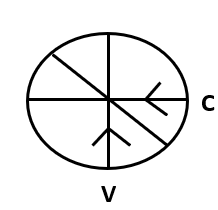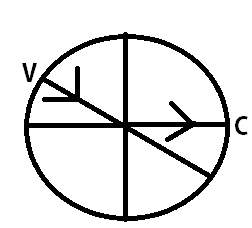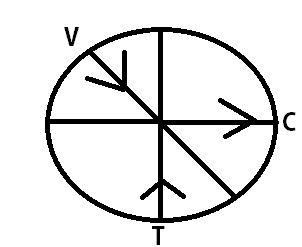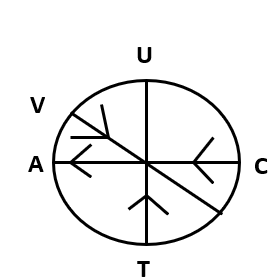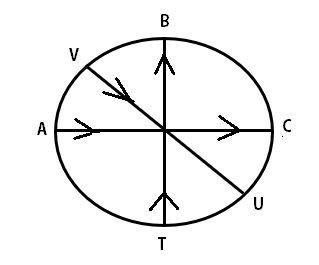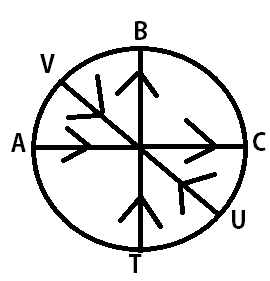Circular Arrangement Facing Centre and Outside






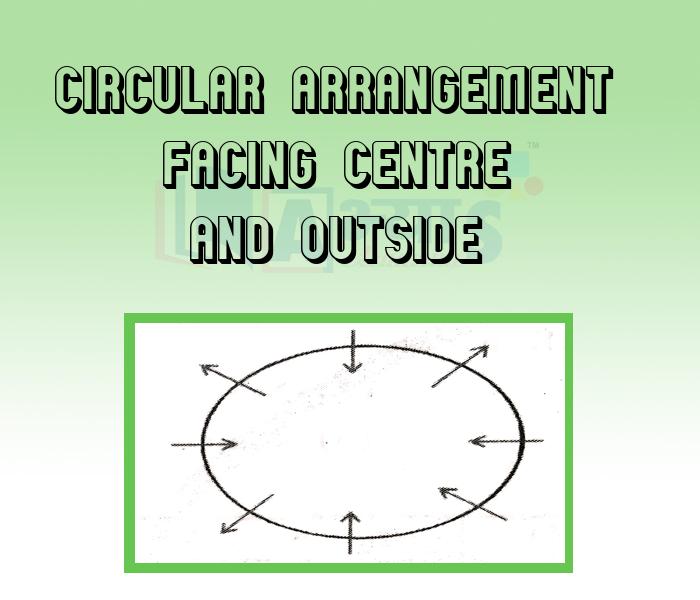
Circular Arrangement Facing Centre and Outside
Seating Arrangement: These type of questions are the most common type in most of the competitive examinations where are reasoning of the candidate is to be analysed. These concepts involve the arrangement of objects/ people in various ways. Generally one problem is followed by five to six questions so it is always advantageous to attempt the seating arrangement questions in the examination, because by solving one problem we are fetching more marks than by solving other single questions.
Circular Arrangement Facing Centre And Outside: In facing away from the center that is outside, left means anti-clockwise while right means clockwise direction. In circular arrangement facing towards the centre means right means anti-clockwise Direction and left means clockwise Direction. As both the concepts are to be applied to the same question, we will draw a diagram depicting the position of the objects or people. When the question arises where both type of sitting is provided, we will follow the rulers of both the directions and draw as many alternatives as available Later, according to the conditions provided the alternatives will get eliminated & only I valid diagram will remain. We will then analyse the position of the various objects or the people and will then answer the questions.
Illustration: Study the following information to answer the given questions :
V, U, T are seated in a circle facing to the centre. A, B, C, are also seated in same circle but two of them are not facing centre (opposite of the centre). V is second to the left of C. U is second to the right of A. B is third to the left of T. C is second to the right of T. A is next to V..
What is position of A with respect to B ?
A. 2nd to the left B. 3rd to the right C. 2nd to the right D. 3rd to the left
Answer: A
Solution: When the question arises where both type of sitting is provided, we will follow the rulers of both the directions and draw as many alternatives as available Later, according to the conditions provided the alternatives will get eliminated & only I valid diagram will remain.
Given : - V, U, T - Facing centre A, B, C, - direction unknown
(a) Since C's direction is not known, it can face inward / outward. So we will form 2 possibilities.
Fig. I |
Fig. II |
(b) Also it is given then C is second to the right of T. So the Fig I gets eliminated as T can't be placed there.After placing T the Fig. II figure will be as shown in Fig. III
Fig. III |
(c) Now it is given U is second to right of A. Two possibilities.
Fig. IV |
Fig. V |
(d) B is third to right of T. So B cannot be placed in Fig. IV. Hence Fig IV is eliminated and after placing B the Fig. V figure will be as shown in Fig. VI. Moreover only two are facing outwards so U will face inwards. Hence the final diagram will be Fig. VII
Fig VI |
Fig. VII |
From the diagram it is clear that counting from B in anticlockwise direct, A is second to the left of B.Hence A is the correct option.
Directions: Study the following information carefully and answer the questions given below:
Eight workers I, J, K, L, M, N, P and Q are sitting around a circular table but not necessarily in the same order. Some of them are facing outward. They are working at four stalls, viz Cloth, Food, Footwear and Books, in a trade fair. Two persons are working at each stall. Note: Facing the same means if one face the centre then the other person also faces the centre and if one person faces outward then the other person also faces outward. Facing opposite directions means if one person faces the centre then the other person faces outward and vice versa.
If L and N interchange their places then who among the following is on the immediate left of P? | |||
| Right Option : D | |||
| View Explanation | |||
Read the comprehension carefully to answer the given question.
Eight persons – A, B, C, D, E, F, G and H are sitting around a circular table, but not necessarily in the same order. Four of them are facing inside while rests of them are facing outside.
C is not adjacent to A, who is facing same direction as B. Two persons are sitting between E and G, who are facing different directions. B is sitting fourth to the left of E, who faces centre. E is sitting second to the right of C. Only one person is sitting between A and H, who are facing different directions. F is to the immediate left of H, who is facing same direction as E. D and F are facing same directions.
Who among the following sits second to the right of G?
| |||
| Right Option : D | |||
| View Explanation | |||
Directions: Study the following information carefully and answer the questions given below:
Eight workers I, J, K, L, M, N, P and Q are sitting around a circular table but not necessarily in the same order. Some of them are facing outward. They are working at four stalls, viz Cloth, Food, Footwear and Books, in a trade fair. Two persons are working at each stall. Note: Facing the same means if one face the centre then the other person also faces the centre and if one person faces outward then the other person also faces outward. Facing opposite directions means if one person faces the centre then the other person faces outward and vice versa.
Who among the following work at the Footwear stall? | |||
| Right Option : D | |||
| View Explanation | |||
Students / Parents Reviews [20]
In terms of methodology I want to say that institute provides expert guidence and results oriented monitering supplements by requsite study material along with regular tests which help the students to improve their education skills.The techniques of providing education helps the students to asses...

Aman Kumar Shrivastava
10thWhen I have not joined Abhyas Academy, my skills of solving maths problems were not clear. But, after joining it, my skills have been developed and my concepts of science and SST are very well. I also came to know about other subjects such as vedic maths and reasoning.

Sharandeep Singh
7thI have spent a wonderful time in Abhyas academy. It has made my reasoning more apt, English more stronger and Maths an interesting subject for me. It has given me a habbit of self studying

Yatharthi Sharma
10thBeing a parent, I saw my daughter improvement in her studies by seeing a good result in all day to day compititive exam TMO, NSO, IEO etc and as well as studies. I have got a fruitful result from my daughter.

Prisha Gupta
8thAbhyas institute is one of the best coaching institute in the vicinity of Ambala Cantt area. The teachers of the institute are well experienced and very helpful in solving the problems of the students.The good thing of the institute is that it is providing extra classes for the students who are w...

Aman Kumar Shrivastava
10thAbhyas is an institute of high repute. Yogansh has taken admission last year. It creates abilities in child to prepare for competitive exams. Students are motivated by living prizes on basis of performance in Abhyas exams. He is satisfied with institute.

Yogansh Nyasi
7thAbhyas institute is one of the best coaching institute in the vicinity of Ambala cantt.The institute provides good and quality education to the students.The teachers are well experienced and are very helpful in solving the problems. The major advantages of the institute is extra classes for weak...

Shreya Shrivastava
8thAbhyas academy is great place to learn. I have learnt a lot here they have finished my fear of not answering.It has created a habit of self studying in me.The teachers here are very supportive and helpful. Earlier my maths and science was good but now it has been much better than before.

Barkha Arora
10thMy experience with Abhyas academy is very good. I did not think that my every subject coming here will be so strong. The main thing is that the online tests had made me learn here more things.

Hiya Gupta
8thThird consective year,my ward is in Abhyas with nice experience of admin and transport support.Educational standard of the institute recumbent at satisfactory level. One thing would live to bring in notice that last year study books was distributed after half of the session was over,though study ...

Ayan Ghosh
8thAbhyas is good institution and a innovative institute also. It is a good platform of beginners.Due to Abhyas,he has got knoweledge about reasoning and confidence.My son has improved his vocabulary because of Abhyas.Teacher have very friendly atmosphere also.

Manish Kumar
10thOne of the best institutes to develope a child interest in studies.Provides SST and English knowledge also unlike other institutes. Teachers are co operative and friendly online tests andPPT develope practical knowledge also.

Aman Kumar Shrivastava
10thAbout Abhyas metholodology the teachers are very nice and hardworking toward students.The Centre Head Mrs Anu Sethi is also a brilliant teacher.Abhyas has taught me how to overcome problems and has always taken my doubts and suppoeted me.

Shreya Shrivastava
8thIt was a good experience with Abhyas Academy. I even faced problems in starting but slowly and steadily overcomed. Especially reasoning classes helped me a lot.

Cheshta
10thWe started with lot of hope that Abhyas will help in better understnding of complex topics of highers classes. we are not disappointed with the progress our child has made after attending Abhyas. Though need to mention that we expected a lot more. On a scale of 1-10, we would give may be 7.

Manya
8thThe experience was nice. I studied here for three years and saw a tremendous change in myself. I started liking subjects like English and SST which earlier I ran from. Extra knowledge gave me confidence to overcome competitive exams. One of the best institutes for secondary education.

Aman Kumar Shrivastava
10thMy experience with Abhyas Academy has been very good. When I was not in Abhyas whenever teacher ask questions I could not speak it confidently but when I came in Abhyas, my speaking skills developed and now I am the first one to give the answer of teachers question.

Upmanyu Sharma
7thA marvelous experience with Abhyas. I am glad to share that my ward has achieved more than enough at the Ambala ABHYAS centre. Years have passed on and more and more he has gained. May the centre flourish and develop day by day by the grace of God.

Archit Segal
7thMy experience was very good with Abhyas academy. I am studying here from 6th class and I am satisfied by its results in my life. I improved a lot here ahead of school syllabus.

Ayan Ghosh
8thAbhyas is a complete education Institute. Here extreme care is taken by teacher with the help of regular exam. Extra classes also conducted by the institute, if the student is weak.

